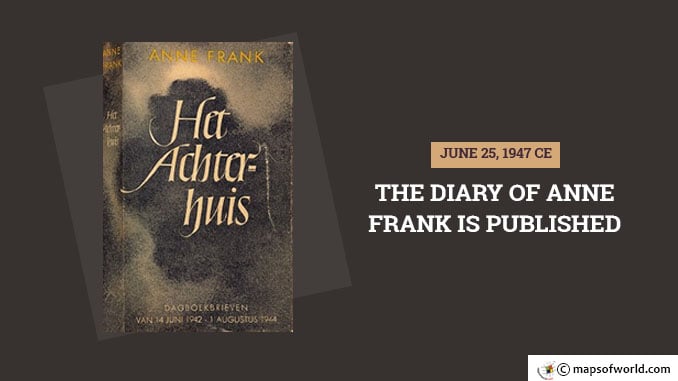One of the most influential books of the 20th century, written by a teenage girl, first reached bookstores on June 25, 1947. The Diary of a Young Girl is more commonly known by the referred to as The Diary of Anne Frank and read the world over to give schoolchildren a unique view of life as a Jew hiding in Nazi-occupied Holland. The story begins shortly after Anne’s 13th birthday. Yet to be driven into hiding, she is much like other girls her age – a childlike wonder she seems to maintain even as she spends month after month locked in an upstairs room near her father’s office with six other people (a seventh joined later). The group would remain there – squeezing into a hidden room when Nazi soldiers searched the building – until August 1944, when they were given up and shipped away to concentration camps. Just a few months before she would be locked in a train car and shipped to Bergen-Belsen, the Dutch Minister for Education, Art and Science went on the radio, appealing to listeners to preserve “simple everyday material” for the sake of creating a narrative to describe the horrors the Dutch faced under Nazi rule. The Dutch government, exiled in London, wanted any scrap of paper its citizens could muster – letters, journals, etc. – to help paint as complete a picture as possible. Inspired, Anne immediately went to work editing her entries with this in mind: entries, which had once been written to various imaginary friends, were soon addressed to “Kitty,” her fictional best friend; stories she felt uncomfortable with were cut; Anne even went so far as to come up with a list of pseudonyms for her roommates in the hiding place. Dreaming to one day be a writer, she worked on the manuscript using her originals as a guide right up until the family was captured. The whole work might have been lost to history if not for Miep Gies and Bep Voskuijl, two women who worked furiously to keep the Franks and other Jews concealed from the Gestapo. In the wake of the arrest, Gies and Voskuijl slipped into the hiding space to recover personal items before they could be removed by the Germans or Dutch police. After Anne’s death due to a typhus infection during March 1945, just two months before the Bergen-Belsen camp would be liberated by the British, Gies and Voskuijl sought out a survivor to pass the possessions along to. Of the eight people who had lived in the hiding space for over two years, only Anne’s father, Otto Frank, survived the war. Reading his daughter’s diary brought back many memories – her detailed descriptions of life produced impeccable clarity of those days in the attic for him. When published on this day in 1947, the book was a commercial success. All 3,000 copies in the first edition of Het Acterhuis – the Dutch name – were sold quickly. An additional five editions went into print by 1950, when the first translator received a contract to compose an English version. Published for the American and British audiences as Anne Frank: The Diary of a Young Girl in 1952, it became a bestseller, with a Pulitzer Prize-winning play following in 1955 and a movie adaptation in 1959. In the years since it first appeared on bookshelves in the Netherlands, The Diary of Anne Frank has been translated into German, Italian, Spanish, Russian, Japanese, Greek and Chinese. The original manuscripts, which remained with Otto Frank until his death in 1980, are now the property of the Netherlands Institute for War Documentation.
June 25, 1947 CE – The Diary of Anne Frank is Published
One of the most influential books of the 20th century, written by a teenage girl, first reached bookstores on June 25, 1947. The Diary of a Young Girl is more…
485
